- Accueil
- Pages cachées
- 13 MARS 2024 NEWS
13 MARS 2024 NEWS
INSTITUT SUPERIEUR D'ANTHROPOLOGIE
INSTITUTE OF ANTHROPOLOGY
ONLINE COURSES / COURS A DISTANCE
INSCRIPTIONS OUVERTES
REGISTER NOW
ESPAGNE – 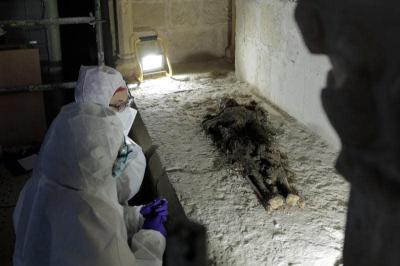 Santes Creus - A team of archaeologists and anthropologists found the human remains of a dozen members of the Catalan nobility dating back to the 13th and 14th centuries at the Royal Monastery of Santes Creus, a Catalan cultural heritage site in northeastern Spain. The discovery was made after the restoration of the ancient Gothic cloister began in April of 2023 and six sarcophagi were opened. The team called the find “exceptional” as it shows a chronological and social class uniformity as well all the diversity of cases, the good state of preservation of bones and bone tissue, and textile remains. According to a press release from the Catalan Ministry of Culture, the royals were buried in Santes Creus after King James II (also known as James the Just or James of Aragon) and his second wife Blanca d’Anjou to turn the monastery into ‘a pantheon of Catalan royalty’. From 1291 to 1327, James served as King of Aragon and Valencia, as well as Count of Barcelona, among other titles. At the Royal Monastery of Santes Creus, restoration work started in April of last year. Their goals included restoring the monastery’s famous tombs and waterproofing the roof. They discovered six stone sarcophagi buried in one of the walls during this process. This room, called the cloister, is well known for housing the massive, elaborately built stone coffins that mark the resting places of many noble families from the 1300s. The sarcophagi within the monastery are adorned with heraldic symbols, aiding in the identification of the nobles entombed within as members of the Cervelló, Cervera, Queralt, Puigvert, and Montcada families. Human tissue and textile fabric samples were carefully extracted from the tombs. These samples are expected to provide invaluable insights into various aspects of the individuals’ lives, including their identities, dietary habits, potential illnesses, living conditions, burial practices, and rituals. When taken as a whole, the investigations may clarify the funerary customs and burial practices of the Catalan nobility in the Middle Ages.
Santes Creus - A team of archaeologists and anthropologists found the human remains of a dozen members of the Catalan nobility dating back to the 13th and 14th centuries at the Royal Monastery of Santes Creus, a Catalan cultural heritage site in northeastern Spain. The discovery was made after the restoration of the ancient Gothic cloister began in April of 2023 and six sarcophagi were opened. The team called the find “exceptional” as it shows a chronological and social class uniformity as well all the diversity of cases, the good state of preservation of bones and bone tissue, and textile remains. According to a press release from the Catalan Ministry of Culture, the royals were buried in Santes Creus after King James II (also known as James the Just or James of Aragon) and his second wife Blanca d’Anjou to turn the monastery into ‘a pantheon of Catalan royalty’. From 1291 to 1327, James served as King of Aragon and Valencia, as well as Count of Barcelona, among other titles. At the Royal Monastery of Santes Creus, restoration work started in April of last year. Their goals included restoring the monastery’s famous tombs and waterproofing the roof. They discovered six stone sarcophagi buried in one of the walls during this process. This room, called the cloister, is well known for housing the massive, elaborately built stone coffins that mark the resting places of many noble families from the 1300s. The sarcophagi within the monastery are adorned with heraldic symbols, aiding in the identification of the nobles entombed within as members of the Cervelló, Cervera, Queralt, Puigvert, and Montcada families. Human tissue and textile fabric samples were carefully extracted from the tombs. These samples are expected to provide invaluable insights into various aspects of the individuals’ lives, including their identities, dietary habits, potential illnesses, living conditions, burial practices, and rituals. When taken as a whole, the investigations may clarify the funerary customs and burial practices of the Catalan nobility in the Middle Ages.
https://arkeonews.net/intact-bodies-of-catalan-nobles-discovered-in-santes-creus-monastery/
TURQUIE – 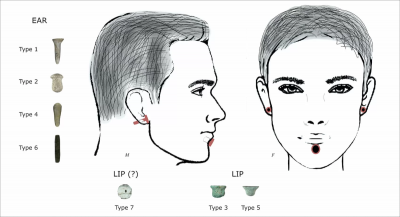
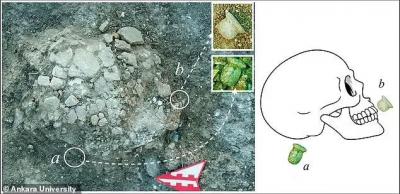
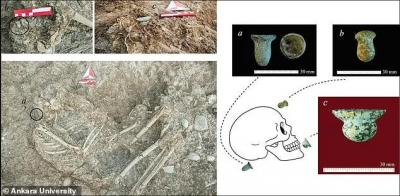 Boncuklu Tarla - Archaeologists have unearthed the earliest known evidence of body perforation in skeletons dating back 11,000 years at the Boncuklu Tarla excavation site in southeastern Türkiye. Furthermore, analysis reveals that only adults had body piercings, indicating that the prehistoric custom might have been a ritual associated with coming-of-age ritual. The findings, which date back to around 11,000 BC, shed new light on early sedentary communities’ body modification practices and call into question existing narratives about their origins in South-west Asia. A team from Ankara University unearthed more than 100 ornaments buried in the graves of 11 thousand-year-old individuals during excavations carried out in Boncuklu Tarla between 2012 and 2017. The ornaments were discovered in situ next to the ears and chins of the skeletal remains, and are mostly made from limestone, obsidian, chlorite, copper, or river pebbles. The variety of the ornaments suggests that they were designed for use in both ear and lower lip piercings known as labrets. This is corroborated by a skeletal analysis of the remains, which shows wear patterns on the lower incisors that match examples of labret wear in various cultures both historically and currently. Further examination revealed that both males and females had piercings, but they were only worn by adults. None of the child burials at the site contained any evidence of these ornaments. This suggests that piercings were not only aesthetic but also had social significance, the researchers said, adding that they are likely to have acted as a rite of passage, signifying a person reaching maturity.
Boncuklu Tarla - Archaeologists have unearthed the earliest known evidence of body perforation in skeletons dating back 11,000 years at the Boncuklu Tarla excavation site in southeastern Türkiye. Furthermore, analysis reveals that only adults had body piercings, indicating that the prehistoric custom might have been a ritual associated with coming-of-age ritual. The findings, which date back to around 11,000 BC, shed new light on early sedentary communities’ body modification practices and call into question existing narratives about their origins in South-west Asia. A team from Ankara University unearthed more than 100 ornaments buried in the graves of 11 thousand-year-old individuals during excavations carried out in Boncuklu Tarla between 2012 and 2017. The ornaments were discovered in situ next to the ears and chins of the skeletal remains, and are mostly made from limestone, obsidian, chlorite, copper, or river pebbles. The variety of the ornaments suggests that they were designed for use in both ear and lower lip piercings known as labrets. This is corroborated by a skeletal analysis of the remains, which shows wear patterns on the lower incisors that match examples of labret wear in various cultures both historically and currently. Further examination revealed that both males and females had piercings, but they were only worn by adults. None of the child burials at the site contained any evidence of these ornaments. This suggests that piercings were not only aesthetic but also had social significance, the researchers said, adding that they are likely to have acted as a rite of passage, signifying a person reaching maturity.
TURQUIE –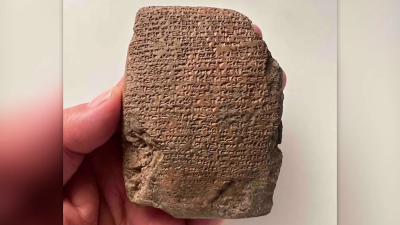 Büklükale - Archaeologists have unearthed a 3,300-year-old clay tablet depicting a catastrophic foreign invasion of the Hittite Empire in Büklükale, about 100 km from Turkey’s capital Ankara. A translation of the tablet’s cuneiform text indicates that the invasion occurred during a Hittite civil war, presumably in an attempt to support one of the fighting factions. Previously, only broken clay tablets had been found in the excavations at Büklükale, but this one is in almost perfect condition. Based on the typology and distribution of the collected pottery shards, Büklükale is thought to be a single-period city belonging to the Hittite Empire Period and having a diameter of 500 m. The palm-size tablet was found in May 2023 by Kimiyoshi Matsumura, an archaeologist at the Japanese Institute of Anatolian Archaeology, amid the Hittite ruins at Büklükale. The Hittites used the Hurrian language for religious ceremonies, Matsumura told Live Science, and it appears that the tablet is a record of a sacred ritual performed by the Hittite king. “The find of the Hurrian tablet means that the religious ritual at Büklükale was performed by the Hittite king,” Matsumura told Live Science in an mail. “It indicates that, at the least, the Hittite king came to Büklükale … and performed the ritual.” According to a translation by Mark Weeden, an associate professor of ancient Middle Eastern languages at University College London, the first six lines of cuneiform text on the tablet say, in the Hittite language, that “four cities, including the capital, Hattusa, are in disaster, ” while the remaining 64 lines are a prayer in the Hurrian language asking for victory. It turns out, the Hurrian writing is a prayer addressed to Teššob (also spelled Teshub), the Hurrian name of the storm god who was the head of both the Hittite and Hurrian pantheons. It praises the god and his divine ancestors, and it repeatedly mentions communication problems between the gods and humans. The prayer then lists several individuals who seem to have been enemy kings and concludes with a plea for divine advice,” Matsumura said.
Büklükale - Archaeologists have unearthed a 3,300-year-old clay tablet depicting a catastrophic foreign invasion of the Hittite Empire in Büklükale, about 100 km from Turkey’s capital Ankara. A translation of the tablet’s cuneiform text indicates that the invasion occurred during a Hittite civil war, presumably in an attempt to support one of the fighting factions. Previously, only broken clay tablets had been found in the excavations at Büklükale, but this one is in almost perfect condition. Based on the typology and distribution of the collected pottery shards, Büklükale is thought to be a single-period city belonging to the Hittite Empire Period and having a diameter of 500 m. The palm-size tablet was found in May 2023 by Kimiyoshi Matsumura, an archaeologist at the Japanese Institute of Anatolian Archaeology, amid the Hittite ruins at Büklükale. The Hittites used the Hurrian language for religious ceremonies, Matsumura told Live Science, and it appears that the tablet is a record of a sacred ritual performed by the Hittite king. “The find of the Hurrian tablet means that the religious ritual at Büklükale was performed by the Hittite king,” Matsumura told Live Science in an mail. “It indicates that, at the least, the Hittite king came to Büklükale … and performed the ritual.” According to a translation by Mark Weeden, an associate professor of ancient Middle Eastern languages at University College London, the first six lines of cuneiform text on the tablet say, in the Hittite language, that “four cities, including the capital, Hattusa, are in disaster, ” while the remaining 64 lines are a prayer in the Hurrian language asking for victory. It turns out, the Hurrian writing is a prayer addressed to Teššob (also spelled Teshub), the Hurrian name of the storm god who was the head of both the Hittite and Hurrian pantheons. It praises the god and his divine ancestors, and it repeatedly mentions communication problems between the gods and humans. The prayer then lists several individuals who seem to have been enemy kings and concludes with a plea for divine advice,” Matsumura said.
GALLES –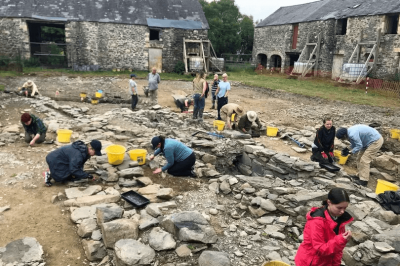 Strata Florida - Archaeologists working in Wales revealed recently they may have discovered a Celtic monastery at the site of a 12th-century Cistercian monastery in Mid Wales. The abbey of Strata Florida – Latin for ‘Vale of Flowers’ has stood in the western heartlands of Wales. Once a great Cistercian monastery in a landscape of immense spiritual importance to the Welsh people for a thousand years. Archaeologists told Nation Cymru that an ancient, possibly (probably) Celtic monastery may have once stood at the location of a Cistercian abbey from the 12th century close to the Cambrian Mountains by the village of Pontrhydfendigaid. The archaeological exploration at the abbey started twenty years ago, initially looking at landscapes and field structures. More recently, the focus shifted to the courtyard of Mynachlog Fawr Farm, which is next door to the abbey. The discovery came amid an analysis of a courtyard next to the abbey, on this farm. These excavations have revealed structures and features under the courtyard, including a major aqueduct and medieval buildings which once formed part of the abbey. The remains of one stone building intrigued archaeologists as it appeared to be earlier than the rest. Three charcoal samples were collected from medieval buildings last summer and sent to radiocarbon dating laboratories. One sample later yielded dates between 1166 and 1268 AD, around the time the abbey was founded. Curiously, however, the other two date ranges came back as 1028-1172AD and 1017-1158AD – long before the abbey was founded in 1184. “The last two of these dates are from the earlier building and, given that the Cistercian abbey was not founded on this site until 1184, they seem to suggest that the building is pre-Cistercian in date,” said the local trust director Carys Aldous-Hughes, according to Nation Cymru. “One of the main focuses of the upcoming 2024 excavations will be the further examination of this building by attempting to find its original floors and any features associated with its earlier use and function. These will offer a glimpse into the history of this site before the Cistercians arrived.” It was recently found that a sizable channel with stone lining crosses the southernmost point of the abbey. Experts now believe this was an aqueduct that brought water from a river to the complex through a series of ponds, dams, and least. The aqueduct was bounded on both sides by a 1.2-meter-wide bank, which raised the channel 1.5 meters above the abbey floors, allowing water to be distributed solely by gravity. Because the banks were made of puddled clay, the structure was completely waterproof. Recent findings have validated the long-held suspicion that the location contained older structures. Archaeologists are now eager to delve further to learn more about the functions of these structures.
Strata Florida - Archaeologists working in Wales revealed recently they may have discovered a Celtic monastery at the site of a 12th-century Cistercian monastery in Mid Wales. The abbey of Strata Florida – Latin for ‘Vale of Flowers’ has stood in the western heartlands of Wales. Once a great Cistercian monastery in a landscape of immense spiritual importance to the Welsh people for a thousand years. Archaeologists told Nation Cymru that an ancient, possibly (probably) Celtic monastery may have once stood at the location of a Cistercian abbey from the 12th century close to the Cambrian Mountains by the village of Pontrhydfendigaid. The archaeological exploration at the abbey started twenty years ago, initially looking at landscapes and field structures. More recently, the focus shifted to the courtyard of Mynachlog Fawr Farm, which is next door to the abbey. The discovery came amid an analysis of a courtyard next to the abbey, on this farm. These excavations have revealed structures and features under the courtyard, including a major aqueduct and medieval buildings which once formed part of the abbey. The remains of one stone building intrigued archaeologists as it appeared to be earlier than the rest. Three charcoal samples were collected from medieval buildings last summer and sent to radiocarbon dating laboratories. One sample later yielded dates between 1166 and 1268 AD, around the time the abbey was founded. Curiously, however, the other two date ranges came back as 1028-1172AD and 1017-1158AD – long before the abbey was founded in 1184. “The last two of these dates are from the earlier building and, given that the Cistercian abbey was not founded on this site until 1184, they seem to suggest that the building is pre-Cistercian in date,” said the local trust director Carys Aldous-Hughes, according to Nation Cymru. “One of the main focuses of the upcoming 2024 excavations will be the further examination of this building by attempting to find its original floors and any features associated with its earlier use and function. These will offer a glimpse into the history of this site before the Cistercians arrived.” It was recently found that a sizable channel with stone lining crosses the southernmost point of the abbey. Experts now believe this was an aqueduct that brought water from a river to the complex through a series of ponds, dams, and least. The aqueduct was bounded on both sides by a 1.2-meter-wide bank, which raised the channel 1.5 meters above the abbey floors, allowing water to be distributed solely by gravity. Because the banks were made of puddled clay, the structure was completely waterproof. Recent findings have validated the long-held suspicion that the location contained older structures. Archaeologists are now eager to delve further to learn more about the functions of these structures.
https://arkeonews.net/excavations-at-the-westminster-abbey-of-wales-yielded-a-few-surprises-a-lost-aqueduct-and-a-buried-celtic-treasure/
NOUVELLE ZELANDE – Aotearoa - Archaeological artefacts are revealing more about the history of human connection to whales and dolphins in Aotearoa New Zealand. Despite their presence in whakapapa, and purakau (oral traditions), very little is on record showing early Māori interactions with cetaceans.
ANGLETERRE – 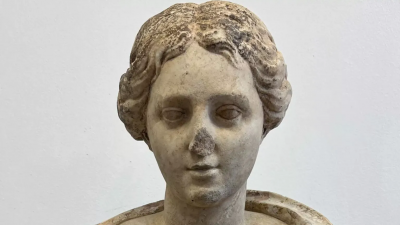 Burghley - A 1,800-year-old Roman marble statue of a woman’s head was discovered during construction in the parking lot of Burghley House near Stamford in Lincolnshire in the United Kingdom. In April 2023, mechanical digger operator Greg Crawley discovered the head of a sculpture. He had uncovered a marble head, which experts have dated to the First or Second Century. Two weeks later the marble bust the head used to be attached to was found. An iron dowel found in the marble head, which probably would have been added in the 18th Century, would have allowed it to be added to a bust or pedestal, experts said. It was an adaptation often carried out by Italian antique dealers at the time to make excavated ancient relics more attractive to traveling aristocrats. It is believed that it was during one of the ninth Earl’s two tours to Italy in the 1760s, when he purchased many antiquities, that he brought the sculpture back to Burghley. The statue depicts “the features of a beautiful Roman lady,” officials said.
Burghley - A 1,800-year-old Roman marble statue of a woman’s head was discovered during construction in the parking lot of Burghley House near Stamford in Lincolnshire in the United Kingdom. In April 2023, mechanical digger operator Greg Crawley discovered the head of a sculpture. He had uncovered a marble head, which experts have dated to the First or Second Century. Two weeks later the marble bust the head used to be attached to was found. An iron dowel found in the marble head, which probably would have been added in the 18th Century, would have allowed it to be added to a bust or pedestal, experts said. It was an adaptation often carried out by Italian antique dealers at the time to make excavated ancient relics more attractive to traveling aristocrats. It is believed that it was during one of the ninth Earl’s two tours to Italy in the 1760s, when he purchased many antiquities, that he brought the sculpture back to Burghley. The statue depicts “the features of a beautiful Roman lady,” officials said.
BRESIL – x Jalapão - Archaeologists at Brazil’s National Institute of Historical and Artistic Heritage (Iphan) discovered 16 new archaeological sites while surveying a large area in Jalapão, in the eastern part of the state of Tocantins. According to a press statement by Brazil’s Ministry of Culture, the sites feature rock art—including human and animal footprints, engraved symbols, and figures representing celestial bodies—thought to have been made around 2,000 years ago. The discovery has been added to an archaeological complex of sites within the Jalapão region, where human occupation has been documented as far back as 12,000 years ago.
Jalapão - Archaeologists at Brazil’s National Institute of Historical and Artistic Heritage (Iphan) discovered 16 new archaeological sites while surveying a large area in Jalapão, in the eastern part of the state of Tocantins. According to a press statement by Brazil’s Ministry of Culture, the sites feature rock art—including human and animal footprints, engraved symbols, and figures representing celestial bodies—thought to have been made around 2,000 years ago. The discovery has been added to an archaeological complex of sites within the Jalapão region, where human occupation has been documented as far back as 12,000 years ago.
https://arkeonews.net/16-new-ancient-rock-art-sites-discovered-in-jalapao-brazil/
CHINE – Changzhou - Archaeologists have discovered a large stone "yue," an axe-like ceremonial artifact, in a 6,300-year-old tomb in east China's Jiangsu Province. The artifact, believed to be the largest well-preserved prehistoric stone yue ever found in China, was recently unearthed from the Sanxingcun relic site in the city of Changzhou. Yue is believed to have originated as a weapon but was later more commonly used in rituals as a ceremonial axe in the Bronze Age. Measuring about 36 cm in width, the stone weapon features a large hole in its center and exhibits no traces of use. It was placed beside the head of the male owner of a tomb noticeably larger than others in the area. "It suggests that over 6,000 years ago, some yue were no longer used as a tool and instead became a symbol of personal status or power," said Li Moran, a researcher with the Institute of Archaeology, Chinese Academy of Social Sciences, who led the site's excavation. The tomb owner was also interred with a stone cauldron, a stone knife and more than 20 lower jawbones of domestic pigs, while another stone yue was placed beside his waist. "The use of stone yue as a scepter and ritual object indicates that the population had started to stratify," Li said, adding that the discovery benefits the study of China's earliest power structure and its evolution. First unearthed in 1993, the Neolithic site of Sanxingcun has seen the discovery of many bone artifacts, stone tools and jadeware in the latest round of excavation starting in April 2023.
http://en.people.cn/n3/2024/0312/c90000-20144205.html
GRECE – 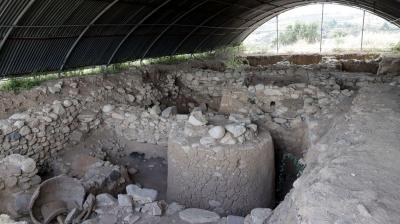 Palaiokastro - Archaeologists have recently uncovered an ancient city in Palaiokastro, Serres.The ancient city appears to have been founded at the end of the 6th century BC and remained in existence into the 6th century AD. Archaeologists who have been conducting research in the area are part of a team led by the Serres Antiquities Ephorate in collaboration with the French School of Athens. They have discovered impressive monuments and gathered data that add to what is already known about the history of this Ancient Greek city. Archaeologists hope to correctly identify name of ancient city “Paleokastro’s location is identified with one of the ancient cities of the lower valley of Struma known [since] ancient historical sources,” the Head of the Ephorate of Antiquities of Serres, Dimitria Malamidou, told AMNA. “We hope that with the new research, there will be findings (inscriptions, coins) that will allow the safe identification of the city’s name,” Malamidou said. “However, it is already obvious that its strategic position between the fertile valley of the river Struma and the slopes of the ore-rich mountains of Kerdyllion and Vertiskos, contributed to its long and successful history.” “It is no coincidence that among the oldest finds, an inscription stands out that mentions the word ‘adamaϛ,’ a term that refers to gold and probably to its exploitation” she added. Efthymios Rizos, an archaeologist of the Ephorate of Antiquities of Serres and a member of the excavation team of the project in Terpni, shares Malamidou’s views. He pointed out that they are already aware of various cities that had flourished in the area in antiquity, but most of these cities cannot be identified with certainty. Rizos also mentioned that excavations and research in Terpni have offered clear evidence as to the ancient city’s lifespan. An inscription confirms that, in Roman imperial times, this settlement had political institutions, he added. The findings have revealed that the area was initially under the control of the Thracian tribe of the Bisaltians. However, it was later settled by Greeks from the cities of the South and the Macedonian Kingdom. Findings of the excavations prove the presence of Greek pottery as early as the 6th century BC. Excavations have also unearthed Hellenistic-era building phases, part of the fortification, a Roman basilica with a complex of thermal baths, a workshop with wine presses (cistern) of Roman times, and two Christian churches of the three-aisled basilica type. Several tombs from various eras have been excavated on its territory, as well as a Macedonian-type tomb belonging to the brothers Ipponakta and Dioscorides. The latter were sons of Apollodorus, who was, according to historical sources, a comrade of Alexander the Great, “says the Head of the Ephorate of Antiquities of Serres.”
Palaiokastro - Archaeologists have recently uncovered an ancient city in Palaiokastro, Serres.The ancient city appears to have been founded at the end of the 6th century BC and remained in existence into the 6th century AD. Archaeologists who have been conducting research in the area are part of a team led by the Serres Antiquities Ephorate in collaboration with the French School of Athens. They have discovered impressive monuments and gathered data that add to what is already known about the history of this Ancient Greek city. Archaeologists hope to correctly identify name of ancient city “Paleokastro’s location is identified with one of the ancient cities of the lower valley of Struma known [since] ancient historical sources,” the Head of the Ephorate of Antiquities of Serres, Dimitria Malamidou, told AMNA. “We hope that with the new research, there will be findings (inscriptions, coins) that will allow the safe identification of the city’s name,” Malamidou said. “However, it is already obvious that its strategic position between the fertile valley of the river Struma and the slopes of the ore-rich mountains of Kerdyllion and Vertiskos, contributed to its long and successful history.” “It is no coincidence that among the oldest finds, an inscription stands out that mentions the word ‘adamaϛ,’ a term that refers to gold and probably to its exploitation” she added. Efthymios Rizos, an archaeologist of the Ephorate of Antiquities of Serres and a member of the excavation team of the project in Terpni, shares Malamidou’s views. He pointed out that they are already aware of various cities that had flourished in the area in antiquity, but most of these cities cannot be identified with certainty. Rizos also mentioned that excavations and research in Terpni have offered clear evidence as to the ancient city’s lifespan. An inscription confirms that, in Roman imperial times, this settlement had political institutions, he added. The findings have revealed that the area was initially under the control of the Thracian tribe of the Bisaltians. However, it was later settled by Greeks from the cities of the South and the Macedonian Kingdom. Findings of the excavations prove the presence of Greek pottery as early as the 6th century BC. Excavations have also unearthed Hellenistic-era building phases, part of the fortification, a Roman basilica with a complex of thermal baths, a workshop with wine presses (cistern) of Roman times, and two Christian churches of the three-aisled basilica type. Several tombs from various eras have been excavated on its territory, as well as a Macedonian-type tomb belonging to the brothers Ipponakta and Dioscorides. The latter were sons of Apollodorus, who was, according to historical sources, a comrade of Alexander the Great, “says the Head of the Ephorate of Antiquities of Serres.”
VIDEO = https://greekreporter.com/2024/03/13/lost-ancient-city-found-serres-greece/
GRECE – 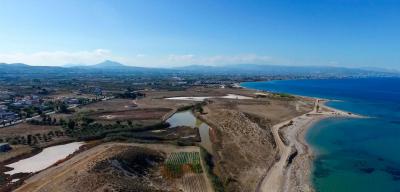 Corinthe - In the ancient Mediterranean, Corinth was an economic powerhouse. Built on a narrow isthmus—a natural choke point between north and south—the city controlled trade between northern Greece and the Peloponnese peninsula. Bound on either side by naturally protected bays, Corinth was also a convenient bridge between the Aegean and Ionian Seas. The city’s main harbor, located along the Gulf of Corinth, was the largest port in ancient Greece. In previous work, archaeologists examining gravesites and historical documents revealed that merchants sailed from the port, known as Lechaion, more than 2,600 years ago, in the 7th century BCE. They did so in ships likely loaded with pottery, perfume, food, and fabrics to trade across the region. But a recent discovery—five lumps of brown coal and a helping of ancient lead pollution—has pushed the history of this pivotal port back by at least 500 years, making it one of the earliest active ports in Europe. The revised history stems from an international research effort that’s been surveying the ancient harbor since 2013. Using hand augers and mechanical drills, French geoarchaeologist Antoine Chabrol of Sorbonne University in France and his colleagues carefully collected cylinders of sediment from the inner harbor, where boats would have pulled upriver to anchor. Analyzing the mud cores, they found a sudden spike in lead levels less than three meters deep. The shift is so sharp and sustained that it could only have been caused by human activity on the riverbanks, says Chabrol. Lead pollution comes from smelting, mining, and metalwork, and the scientists dated the pollution in the port to as early as 1381 BCE—3,405 years ago—during the Bronze Age. The five chunks of brown coal, each no bigger than a matchbox, add further evidence of the port’s antiquity. These fragments are a specific kind of coal called lignite, and the pieces collected from the harbor’s sediment date to as early as 1122 BCE. The nearest known source of lignite is more than 50 kilometers away, suggesting merchants were importing the fossil fuel nuggets to stoke their harborside furnaces by the 12th century BCE. Bronze Age ships might have paddled from port carrying urns of olive oil, bulk bins of fruit, and narrow-necked jars of wine to Crete, Cyprus, and beyond. But so far, while the team has found convincing evidence of Bronze Age activity in Corinth’s port, they’ve yet to find pieces of the actual port from this era. The physical evidence found at the site so far—including stone piers, wooden pillars, and a possible lighthouse—dates to the first century CE or later, during the Roman period. But even without physical Bronze Age structures, the findings show that Corinth’s port was used consistently for nearly 2,600 years. From the 13th century BCE to the 13th century CE, Mycenaean, Phoenician, Roman, and Byzantine ships would have sailed from this strategic location. “You can detect their presence in one single site,” says Panagiotis Athanasopoulos, an archaeologist at Greece’s Danish Institute at Athens and a collaborator on the project. “It’s like the very essence of historical continuity.” Incredibly, though, even this revised age might be an underestimate. Archaeologists have previously found evidence of people traveling through Corinth more than 8,000 years ago, as well as pots from a late Stone Age culture that lived to the northwest, along the Adriatic Sea. Bjørn Lovén, co-director of the Lechaion Harbour Project and coauthor of the new paper, says this suggests Corinth’s maritime trade network may extend even deeper into history. Nafsika Andriopoulou, a geoarchaeologist at the Foundation for Research and Technology–Hellas’ Institute for Mediterranean Studies in Greece who was not involved in the study, says a broader analysis of what metals might be in the soil could help fill in even more details. For example, tracking other metals—such as copper, the main component of bronze—could tell geoarchaeologists even more about the port’s early uses. Similar sampling in nearby locations could even help reveal ancient trading routes, Andriopoulou adds. The team will continue their work during the summer of 2024, looking for more clues of ancient commerce and bringing renewed activity to this long-bustling port.
Corinthe - In the ancient Mediterranean, Corinth was an economic powerhouse. Built on a narrow isthmus—a natural choke point between north and south—the city controlled trade between northern Greece and the Peloponnese peninsula. Bound on either side by naturally protected bays, Corinth was also a convenient bridge between the Aegean and Ionian Seas. The city’s main harbor, located along the Gulf of Corinth, was the largest port in ancient Greece. In previous work, archaeologists examining gravesites and historical documents revealed that merchants sailed from the port, known as Lechaion, more than 2,600 years ago, in the 7th century BCE. They did so in ships likely loaded with pottery, perfume, food, and fabrics to trade across the region. But a recent discovery—five lumps of brown coal and a helping of ancient lead pollution—has pushed the history of this pivotal port back by at least 500 years, making it one of the earliest active ports in Europe. The revised history stems from an international research effort that’s been surveying the ancient harbor since 2013. Using hand augers and mechanical drills, French geoarchaeologist Antoine Chabrol of Sorbonne University in France and his colleagues carefully collected cylinders of sediment from the inner harbor, where boats would have pulled upriver to anchor. Analyzing the mud cores, they found a sudden spike in lead levels less than three meters deep. The shift is so sharp and sustained that it could only have been caused by human activity on the riverbanks, says Chabrol. Lead pollution comes from smelting, mining, and metalwork, and the scientists dated the pollution in the port to as early as 1381 BCE—3,405 years ago—during the Bronze Age. The five chunks of brown coal, each no bigger than a matchbox, add further evidence of the port’s antiquity. These fragments are a specific kind of coal called lignite, and the pieces collected from the harbor’s sediment date to as early as 1122 BCE. The nearest known source of lignite is more than 50 kilometers away, suggesting merchants were importing the fossil fuel nuggets to stoke their harborside furnaces by the 12th century BCE. Bronze Age ships might have paddled from port carrying urns of olive oil, bulk bins of fruit, and narrow-necked jars of wine to Crete, Cyprus, and beyond. But so far, while the team has found convincing evidence of Bronze Age activity in Corinth’s port, they’ve yet to find pieces of the actual port from this era. The physical evidence found at the site so far—including stone piers, wooden pillars, and a possible lighthouse—dates to the first century CE or later, during the Roman period. But even without physical Bronze Age structures, the findings show that Corinth’s port was used consistently for nearly 2,600 years. From the 13th century BCE to the 13th century CE, Mycenaean, Phoenician, Roman, and Byzantine ships would have sailed from this strategic location. “You can detect their presence in one single site,” says Panagiotis Athanasopoulos, an archaeologist at Greece’s Danish Institute at Athens and a collaborator on the project. “It’s like the very essence of historical continuity.” Incredibly, though, even this revised age might be an underestimate. Archaeologists have previously found evidence of people traveling through Corinth more than 8,000 years ago, as well as pots from a late Stone Age culture that lived to the northwest, along the Adriatic Sea. Bjørn Lovén, co-director of the Lechaion Harbour Project and coauthor of the new paper, says this suggests Corinth’s maritime trade network may extend even deeper into history. Nafsika Andriopoulou, a geoarchaeologist at the Foundation for Research and Technology–Hellas’ Institute for Mediterranean Studies in Greece who was not involved in the study, says a broader analysis of what metals might be in the soil could help fill in even more details. For example, tracking other metals—such as copper, the main component of bronze—could tell geoarchaeologists even more about the port’s early uses. Similar sampling in nearby locations could even help reveal ancient trading routes, Andriopoulou adds. The team will continue their work during the summer of 2024, looking for more clues of ancient commerce and bringing renewed activity to this long-bustling port.
https://hakaimagazine.com/news/ancient-greeces-biggest-port-is-older-than-we-thought/
